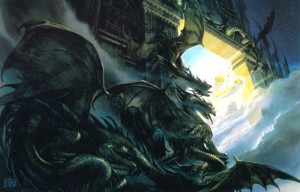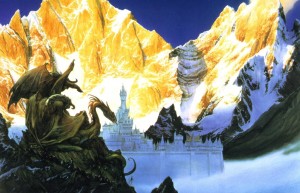 The quest for Middle-earth canon. In some ways it always feels a bit of a Sisyphean endeavour.
The quest for Middle-earth canon. In some ways it always feels a bit of a Sisyphean endeavour.
You know the story of the mythological Greek king, Sisyphus, right?
For those who don’t recall, Sisyphus was just too crafty for his own good. So the Greek gods, never tolerant of being made to look foolish, designed for him the most frustrating of punishments: Sisyphus was compelled to roll a huge boulder up a steep hill. Just before he could reach the top, it would roll back down, forcing him to begin all over again.
Consistency and canon in Tolkien always feels a bit like that — something that hovers just out our of reach. More, the harder you push for it, the more it slips away from you.
The answer you seek isn’t in quite The Lord of the Rings, so you start examining what Tolkien wrote in the published Silmarillion. But that’s still too vague, so you delve into Unfinished Tales or the History of Middle Earth. You might find some hints, but they’re at best fragmentary, or worse, the stories offer conflicting information!
Of course, as humans we feel compelled to seek consistency and place things within a coherent framework — a framework that does not always exist.
Which is why people twist themselves into knots of logic to try and make sense of conflicting evidence of whether Balrogs do or do not have wings.
Or whether Galadriel departed Valinor with Feanor’s rebels, or — as Tolkien later preferred but never integrated into the Quenta Silmarillion texts — left independently but at the same time.
Or… well, I could go on, but I’m sure you get the idea.
Tolkien canon has a natural limit…
The fact is that no matter how hard you work at it, no matter how many resources you consult, there’s a limit to how consistent you can make canon. For some things in Arda, there is simply no single, definitive answer.
My take is that this inevitable inconsistency is not not only not necessarily bad, but actually a good thing. This may seem counter-intuitive, but I believe the uncertainty about “factual truth” works to increase our investment in the story.
Why? It makes us ask questions and discuss what “really” happened. We question and discuss not in the hope of a definitive answer, but as a means of discussing alternatives hypotheses.
It’s worth considering that history — or more precisely — our knowledge of it, is messy and fractured. And the further one tries to delve into history, the more fragmentary and conflicting this knowledge tends to become.
 This is self-evident. Oral traditions fail; records are lost, destroyed.
This is self-evident. Oral traditions fail; records are lost, destroyed.
The fractured, incomplete and contradictory nature of Tolkien’s legendarium mirrors this — and this is one of the keys to its deep verisimilitude.
It helps make it more believable, not less.
Just think how many ancient records of the Edain would have been lost in the Akallabeth when Numenor sank beneath the waves. Consider how many more would have been lost in the sack of Ost-in-Edhil by Sauron, in the destruction of Osgiliath during Gondor’s terrible kin-strife, and in the decades when Arnor dissolved under the twin influence of internal strife and the assaults of Angmar. More — much more — was lost than just the Palantiri, I fancy.


